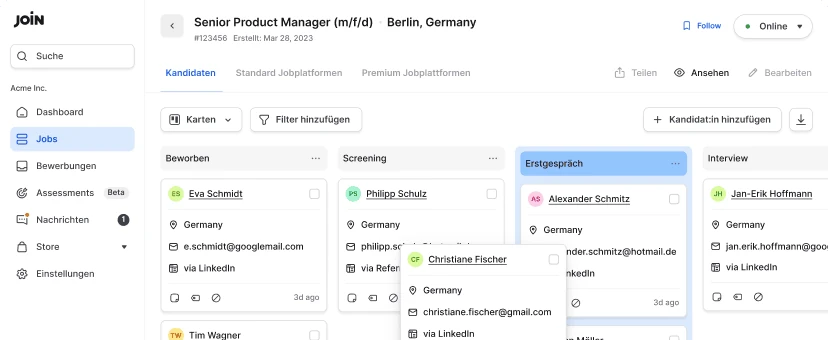How to start agile recruiting strategies to improve your talent acquisition
Traditional hiring strategies can be time-intensive, expensive, and inefficient. If you want to attract the best talent today, it’s time to adopt agile recruitment. Here’s how you do it!
Table of contents
What is agile recruiting?
Agile recruitment is a popular hiring strategy inspired by the Agile Manifesto, a project management methodology created by software development professionals in 2001.
Key aspects of the agile process include adaptability, collaboration, and continuous improvement. The agile method also sees projects and larger tasks broken down into more manageable “sprints.”
Today, this project management approach has been embraced by many industries, including in recruitment.
The agile recruiting model uses the core principles of the framework it’s based upon. It supports a culture of open communication, encouraging regular feedback between those involved in the hiring process. Agile recruiting is also more responsive than other hiring methods, helping control costs and alleviate the burden on HR teams.
Another essential part of agile recruiting is working in the earlier-mentioned sprints. Generally speaking, the first hiring sprint is dedicated to planning. Here, hiring teams are selected, resources are allocated, and the specifics of a role are discussed.
The second sprint often focuses on advertising the role itself, such as publishing the job ad on online job boards. This is the talent attraction part of the process—and the part where JOIN’s free recruitment software can help. The third sprint in agile recruiting is generally spent evaluating applications and screening applicants.
With JOIN, you can multipost your job ads to 15+ free and 250+ premium job boards. And all incoming applications are easily tracked and managed inside JOIN’s free applicant tracking software.
Sign up for free, and see for yourself!
Why do so many businesses turn to agile recruitment?
The labour market has changed considerably in just a few years. Nowadays, there’s no such thing as a typical workplace, with more hybrid and remote positions than ever before.
Talent shortages have given job seekers significant leverage while making it harder for companies to secure high-quality candidates for vacant positions. However, this isn’t the only obstacle that hiring teams face:
Lack of collaboration and long hiring timelines
Along with talent shortages, a lack of internal collaboration can hinder the recruitment process. It’s not unusual for members of a hiring team to have different priorities, but too much conflict can grind recruitment to a halt.
Not enough data
Data-driven recruitment strategies can help sidestep conflicting priorities. However, many organisations fail to use available metrics to help with talent acquisition.
Key talent acquisition metrics like cost per hire, applicants per role, and offer acceptance rate can all be used to help an indecisive hiring team reach a majority decision.
Outdated technology
Without up-to-date technology and the right tools, your recruitment drives are doomed to fail. Even if you’re using the best HR software systems, suboptimal configuration can hamper progress and lead to missed recruitment goals.
Sign up with JOIN today to unlock the full potential of agile talent acquisition. With JOIN, it’s easy to create great role descriptions and post jobs for free, while our full-featured Applicant Tracking System (ATS) will streamline your workflows. You can even integrate your favourite HR tools!

Why it’s time to embrace an agile recruiting model
Using agile in recruitment strategies offers a bunch of benefits. Businesses can respond to market trends quickly, while candidate experience can be refined to attract the best talent.
However, this is just the tip of the iceberg. Below, we’ll explore some of the biggest benefits of agile recruiting in more detail.
Reduce your time to hire
From the moment you want to fill a role to the time your new employee is actually onboarded can take weeks, if not months. By using sprints and streamlined workflows, the agile recruiting process makes it easier to secure the best talent more quickly, helping you reduce your time to hire.
A flexible approach to recruitment
Business needs change all the time, and so does the labour market. To meet organisational goals, you’ll need a responsive recruitment strategy. In fact, adaptability in recruitment was one of the recruiting trends predicted for 2024.
Fortunately, flexibility is ingrained into the fabric of agile hiring. You can adapt to respond to market trends, project demands, or growth objectives.
Enhanced candidate experience
In a saturated market that favours job seekers, candidate experiences have never been more important.
Full life cycle recruiting processes like the agile method allow for greater collaboration between recruiters and candidates. Increased transparency fosters a culture of trust and inclusivity, creating a candidate-centric experience that reflects well on your brand.
Use analytics for continuous improvement
As the agile hiring process is divided into short sprints, recruiters can monitor key metrics and analytics more easily.
This makes it easier to spot red flags that may be hindering the hiring process. Analytics will quickly reveal any problems, allowing you to make the necessary changes to get your recruitment efforts back on track.
Optimised workflows and productivity gains
The agile approach to recruiting is geared toward finding the best candidates quickly. By not having to adhere to standard procedures, hiring teams are free to optimise their workflows. This, along with a keen focus on collaboration, can significantly enhance productivity.
Improve your quality of hire metrics
A high offer acceptance rate is all well and good, but it’s important to retain talent for as long as possible. Meticulous candidate selection and evaluation are central to agile recruiting. This thorough approach ensures only the most suitable candidates progress to the interview stage.
How to implement agile recruitment models (in 8 steps)
Are you struggling to meet your recruitment goals? Perhaps your current employee selection methods aren’t as meticulous as they could be.
Implementing agile recruitment solves both of these problems and more. Not sure where to start? Read on for a breakdown of how you can make agile recruitment work for you.
1. Establish role requirements
This is the first step in any recruitment cycle. Once you’ve identified which position needs to be filled, you can start outlining role requirements. Whether you’re hiring a project manager or advertising an entry-level position, being upfront about expectations will increase the quality of hire.
2. Choose your hiring team wisely
You can now put together your agile recruiting team. The project owner and leader are at the top of the pile, so these roles must be assigned first. It’s then down to the project leader to assemble the rest of the team.
For best results, consider cross-functional teams that can bring different perspectives to the process.
3. Define KPIs
Key performance indicators (KPIs) are key to analysing the success of recruitment processes. There are many metrics you can use, including source of hire, cost per hire, and offer acceptance rate.
You’re not bound to your starting metrics, so feel free to mix things up if they’re bringing you the insights you need.
Suggested read: Top 15 recruitment KPIs to track
4. Break large tasks into sprints
Dividing larger hiring projects into sprints allows for easier allocation of team members and resources. It also lets you set realistic timeframes for completion and lets you prioritise what’s most important.
5. Visualise the hiring process
Using tools like a Kanban board can help hiring teams visualise project progress. They’re a useful tool for applicant tracking, with a Kanban recruitment board letting you contextualise the status of every eligible candidate.
6. Standup meetings
Standup meetings can be held daily or weekly. Include a rundown of what’s happened since the last meeting and what tasks need to be completed. Any obstacles or delays should also be mentioned. To keep things focused, ensure no meeting runs beyond 15 minutes.
7. Keep communication lines open
Communication is key to a positive agile hiring outcome. Project leaders should ensure everyone has all the information they need to complete their tasks. Hiring managers can be meticulous when it comes to candidate selection, so focus on nurturing positive relationships with them to avoid conflict.
8. Evaluate and improve
You don’t have to wait until the end of the hiring process to find out whether the agile method is working for you.
At the end of every sprint, turn to analytics and assess your data to what’s working and what isn’t. One of the core principles of the agile methodology is continuous improvement, so don’t be afraid to make changes.
Ready to reap the rewards of agile recruiting?
Do you want to future-proof your hiring strategies and ensure you can keep up with market shifts or changing business needs?
Then agile hiring is the way to go. Highly responsive and incredibly adaptable, the agile approach can be easily tailored to the needs of your business. However, you’ll need the right tools at your disposal to unlock the full potential of agile hiring.
With a talent acquisition software solution like JOIN, you’ll have access to all the features you need to optimise your recruitment efforts. From AI-powered job ad creation, to multiposting to 250+ job boards with one click, to integrated candidate tests and assessments.
Start hiring better, faster. It’s easy, with JOIN:
Frans Lelivelt
Frans is JOIN's multilingual Senior Content Manager. His main topic of interest in the recruitment space is DEI and how companies can reduce their (unconscious) biases to make the world of work a fairer, kinder place for everyone. Outside of work, he tries to do the same for animals, spending much of his spare time in the kitchen preparing plant-based feasts.


![Sourcing passive candidates in 8 unique ways [how to]](https://cdn-public-assets.join.com/2023/07/02ccd07a-passive-sourcing.jpg)